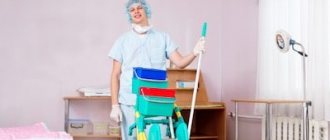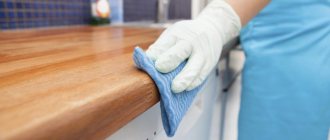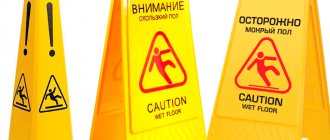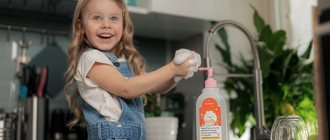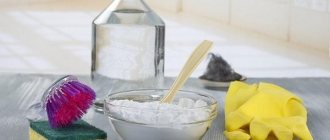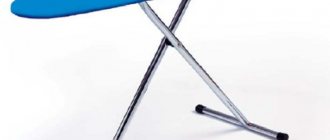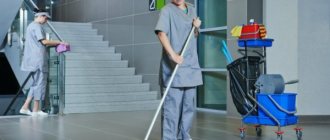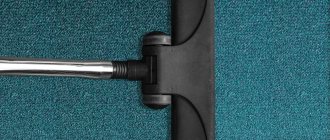“Cleanliness is the key to health!” - the good old truth. Where it is clean, there is less dust, it is easier to breathe, there are fewer pathogenic microbes, it is generally pleasant to be. Regular home cleaning is an integral part of our lives.
Previously, cleaning a house or apartment primarily fell on women's shoulders. Traditionally, women were responsible for comfort and order. Nowadays, household work is greatly facilitated by automatic assistants. A washing machine washes clothes, a dishwasher will handle dirty dishes, a robot vacuum cleaner will clean the floor, and a window cleaning robot will clean the windows; even cleanliness and a pleasant aroma in the room are ensured by air purifiers, humidifiers and fragrances.
In production, cleaning and maintaining cleanliness are also given great attention. Maintenance of cleanliness is carried out by separate departments or cleaning companies for hire. Contracts are often concluded with third-party companies that provide services for sanitization and disinfection of premises, surfaces, equipment and ventilation systems from pathogenic microbes.
Supervisory authorized bodies strictly monitor compliance with sanitary rules and regulations both in organizations and institutions, and the quality of professional cleaning and disinfection services of cleaning companies! Sanitary measures are regulated by many regulatory documents and controlled by Rospotrebnadzor and sanitary and epidemiological services (SES).
For each field of activity, its own Sanitary Rules and Norms (SanPiNs) and Sanitary and Epidemiological Rules (SP) and other regulatory documents have been developed.
Traditionally, special requirements are imposed on organizations and institutions:
- healthcare (hospitals, clinics, clinics, laboratories, treatment rooms, surgical rooms);
- food production;
- public catering (cafes, restaurants, bars, canteens);
- educational and children's institutions (schools, kindergartens, development and entertainment centers);
- pharmaceutical production and pharmacies;
- sports complexes, swimming pools, fitness rooms;
- service industries (beauty salons, hairdressers, nail salons, solariums, massage rooms, spas);
- entertainment sectors (cinemas, theaters, gaming halls).
The degree of strictness of sanitary requirements varies. By the way, the sanitary requirements for the cleanliness of the treatment room and surgical room are maximum, because there must be not just clean, but sterile conditions. And due to the COVID-19 pandemic, the list of organizations controlled by Rospotrebnadzor and SES and the requirements for them has expanded. It is necessary to additionally treat premises, equipment and surfaces with disinfectants.
In connection with the prevention of COVID-19, Rospotrebnadzor, in recommendations dated September 29, 2020, prescribed that all organizations are required to carry out special sanitary treatment and disinfection of premises and air, with a record of the sanitary measures carried out in the disinfection log.
As a rule, routine cleaning is carried out twice a day, and the second time is usually at the end of the working day. The exception is for rooms where it must be sterile, for example, cleaning a treatment room is carried out with mandatory quartzing.
Cleaning in medical institutions according to SanPiN in 2022
In 2022, in the context of coronavirus, special attention is paid to cleaning in medical institutions in SanPiN 3.3686-21, the standard included all current standards from the no longer valid SanPiN 2.3.1.2630-10. The requirement to thoroughly clean all items in the room using detergents and disinfectants has not become obsolete. The profile of a particular object affects the frequency of cleaning. Eg:
- dressing rooms are cleaned 2 times a day with washing of floors, walls, handles;
- postoperative wards require thorough cleaning twice a day.
Regular wards are cleaned once a day. Corridors with stairs and toilets with toilets are washed twice. Wall surfaces are cleaned once a quarter.
Treatment of premises during coronavirus at the enterprise
If employees have not been transferred to remote work, then they simply need to ensure maximum safety.
The cleaning of premises against coronavirus is the responsibility of cleaners of industrial premises. They maintain cleanliness and order in accordance with the requirements of the employer. To do this, they use different tools, equipment, and chemicals that help clean the premises and disinfect and disinfect them.
Particular attention is paid to public places: toilets, gyms, eating areas and rest rooms. Disinfection in such rooms should be carried out every two hours.
Cleaners thoroughly wipe down walls, floors, work surfaces, door handles, tables and chairs, and all equipment using disinfectants. Then the premises must be ventilated for 15-20 minutes. This regime helps prevent the spread of coronavirus and ensure safety for all workers
Disinfection in such rooms must be carried out every two hours. Cleaners thoroughly wipe down walls, floors, work surfaces, door handles, tables and chairs, and all equipment using disinfectants. Then the premises must be ventilated for 15-20 minutes. This regime helps prevent the spread of coronavirus and ensure safety for all workers.
Disinfection of office premises should be carried out twice a day. But if infected people are identified at work or those who have previously been in contact with sick people, cleaning is carried out every two hours.
Do I need to create a schedule for sanitizing surfaces during Covid?
To prevent the spread of coronavirus within the organization, a special schedule is drawn up for treating surfaces in office premises. This is an important document to follow. It allows you to maximally protect employees at the enterprise and prevent the spread of the virus.
After all, employee safety is the most important criterion during the Covid pandemic.
Compilation rules
A schedule for sanitizing surfaces is drawn up in any form. This document is necessary for employees who are responsible for carrying out these events.
A schedule is drawn up on an A4 sheet, which indicates the initials and position of the responsible person, as well as the name of the premises.
There must also be a signature of the person who carries out this processing and the signature of the person who monitored all these activities. This schedule allows the cleaner to know when to clean the area next.
The disinfectants used are safe for employees. Therefore, sanitary treatment of surfaces can be carried out in the presence of personnel. This is very convenient, because specialists can not stop working while carrying out these preventive measures.
The results of the sanitation carried out are recorded in a special journal for recording surface treatment for Covid-19.
General cleaning in medical institutions according to SanPiN
The frequency of general cleaning in medical institutions according to the new SanPiN in 2022 is carried out in the same way as according to the old standard - with special care. Using detergents and disinfectants, treat:
- floors;
- furniture;
- equipment;
- window sills;
- doors;
- walls;
- inventory;
- lamps.
Once every 7 days, perform general cleaning in the room where the aseptic regime is installed:
- in the operating room;
- dressing;
- maternity ward;
- procedural;
- manipulative.
Regardless of the schedule, the premises are “generalized” if the inspection shows an unsatisfactory result when taking samples for microbial contamination of the environment, as well as if there are unsatisfactory epidemiological indications. General cleaning in a medical facility differs from normal cleaning in the regime for the use of disinfectants. For routine cleaning, there is a regime to ensure the death of bacteria. If an object contaminates blood or biological substrates, an antiviral regime occurs. General cleaning is always accompanied by the use of strong disinfectants to destroy bacteria, viruses, and fungi. Limits the death of bacteria in the premises:
- wards;
- doctors' offices;
- AHP;
- diagnostic rooms.
The staff involved in cleaning a medical facility tries to carry out the procedure effectively; the health and life of people depends on the quality.
Maintaining cleanliness by students
Schoolchildren should not be involved in cleaning in an educational institution. This is prohibited by the law of the Russian Federation. However, teachers can involve students in activities that have been included in the educational plan, such as duty.
This type of work involves simple labor activities in which children are involved. For example, those on duty can wipe the blackboard after class, take out the trash (not food waste), water the flowers, and set the table in the dining room. To ensure that all students are involved in duty, the teacher creates a list.
Duties are organized within the framework of labor education. This direction begins to be actively explored in kindergarten.
In this way, children learn to understand the importance of keeping the room clean and are introduced to useful activities.
It is possible to organize duties in the open air, which are carried out like subbotniks. Teachers monitor their implementation. They are required to carry out instructions, provide children with the necessary equipment and ensure compliance with safety rules.
Children should not be involved in cleaning toilets, corridors or technical areas. To process them, the educational institution has special staff.
Surface treatment in honey. institutions
SanPiN 2022 requires that surfaces in medical institutions be hygienically intact after treatment. At the same time, not only thorough cleaning should ensure perfect cleanliness:
- each wall;
- gender;
- ceiling;
- furniture with equipment;
- heating devices with tools, lamps.
On any surface there should not be:
- cracks;
- cracks;
- rust and other damage.
Only on smooth objects will dust not accumulate and be absorbed. Each surface is wiped with a rag dampened with the disinfectant composition. The air and surfaces are subjected to additional treatment with bactericidal irradiators. After cleaning, the surfaces of sanitary equipment are wiped with a wet rag soaked in a cleaning and disinfectant. All equipment that was used in cleaning in the form of rags, napkins, sponges and washcloths is washed in a solution with paste or washing powder.
IMPORTANT
Each individual facility should have its own separate cleaning tool. The orderlies end their work day with the final cleaning of the premises. This requires cleaning and disinfection of all surfaces where patient health procedures were performed. As well as floors and walls at height.
Dry cleaning is not carried out in hospitals and clinics; vacuum cleaners are not used, except in administrative buildings where there are carpets. The importance of every cleaning in a medical institution requires the management to conduct job training and familiarization with the current SanPiN in 2022 before the appointment. The head nurse monitors the quality of cleaning procedures according to sanitary standards, and she also draws up a schedule for general cleaning. The cleanliness of a clinic or hospital ensures that the spread of bacteria and infections is excluded. The thoroughness of cleaning is not determined by the requirement of the chief physician, but by SanPiN. The head ensures the implementation of the rules for medical institutions.
Services and their cost
The cost of cleaning in a kindergarten depends on the prices of the selected cleaning company, the volume and type of work to be done.
Approximate prices:
- Area less than 100 m2: daily - 5500 rubles, general - 7500 rubles.
- Area 250 m2: daily – 7500 rubles, general – 12500 rubles.
- Area more than 300 m2: daily - from 35 rubles per square meter, general - from 70 rubles per square meter.
Daily cleaning in the group includes the following types of work:
- wiping dust from all surfaces, including mirrors and glass;
- cleaning carpets with a vacuum cleaner;
- washing window sills and baseboards;
- floor cleaning;
- making beds;
- taking out the trash.
If the cleaning is general, then the following types of work are added to the listed items:
- Vacuuming upholstered furniture.
- Washing all lighting elements.
- Moving furniture aside and washing the floor behind it.
- Washing heating appliances.
- Cleaning inside cabinets, dusting shelves.
- Cleaning radiators with a steam generator.
You will have to pay separately for cleaning after the repair. The price starts from 13,500 rubles per 200 m2. This treatment involves eliminating all visible consequences of the repair, for example, removing grout, traces of paint, plaster, etc.
Before entrusting the processing of the preschool territory to a cleaning company, you need to clarify with what detergents they will use to carry out the task.
All disinfectant compositions must meet safety requirements and not pose a threat to the health of children. Workers performing cleaning in preschool educational institutions are required to have valid sanitary certificates.
Cleaning equipment
Providing cleaning equipment for medical institutions according to SanPiN in 2022 and storing them in appropriate conditions is as important as cleaning itself in medical institutions. Sanitary rules are created and followed to prevent the spread of viral and bacterial infections. The staff of medical clinics must maintain hygiene, and for this they are equipped not only with the necessary cleaning equipment, but also with high-quality, safe equipment in accordance with the criteria of healthcare facilities, types, labeling and requirements for its use according to SanPiN. Wash floors and perform wet cleaning using:
- buckets;
- sex rags;
- cleaning carts;
- screeds;
- brooms;
- scrapers;
- brushes;
- shovels for cleaning the yard and the entrance steps to the hospital.
SanPiN 2.1.3678-20 in section 4 details how to operate the premises of organizations that provide medical services in 2022. Section 2 is devoted to the requirements for cleaning equipment in hospitals. In particular, it states that clinic equipment must meet the following requirements:
- surfaces contain color markings by type of work and purpose of cabinets;
- each item is stored in a hospital dressing room or pantry in a special cabinet;
- after cleaning, all equipment is disinfected;
- the room where equipment is stored, where maintenance personnel are located, must contain trays, sinks, settling tanks, sinks with watering cans.
Hospital cleaning equipment is selected depending on the cleaning method and the type of office, which determines the quality of the procedure. Correctly selected material:
- reduces the degree of injury;
- creates an environment that is safe for cleaning;
- improves the result.
A “mop”, a special attachment, is attached to the mop for cleaning the floor. Which needs to be processed after use. To do this, clean visible dirt with a brush. According to SanPiN for medical institutions, equipment processing includes:
- removing visible dirt from the instrument;
- changing mop attachments that can be washed in a washing machine;
- mops are cleaned in a special solution, then rinsed;
- The water temperature is maintained depending on the material
- After treating the floor of 20 m2, wash the rags, change the nozzle, and put the dirty one in a bag.
IMPORTANT
Buckets and rags must be used differently for each office. At the end of cleaning, mops with napkins are sent for washing. The following application is possible only after thermochemical treatment.
Cleaning a toilet in a medical facility according to SanPiN
In accordance with the provisions of SanPiN 2.1.3678-20, toilets with enema and sanitary rooms belong to class “G”. Research by health experts has shown that toilets are not always a source of infection. Microelements are washed off with water and die in feces as soon as the medium dries out. For microorganisms there is a positive substance on the handles of brushes and brushes. In hospitals, toilets are the most difficult areas to clean; there are many hard-to-reach places - behind the toilet cistern, under radiators and bathtubs.
And according to the sanitary rules of medical institutions in 2022, dirt must be cleaned from each:
- sink;
- toilet;
- shower cabin;
- bathroom;
- trouble;
- tap.
Limescale deposits and traces of corrosion remain on the taps and around the device. Toilets need to be cleaned of urinary stones. Traces of water splashes, along with detergents from the hands of patients, are visible on the tiles and walls of the devices.a
Toilet and sanitary facilities are cleaned by trained personnel in the following sequence:
- collect and dispose of waste;
- wipe down pieces of furniture - cabinets
- treat the surfaces of walls, doors, windows, mirrors;
- wash baths;
- clean sinks and toilets;
- washing the floor;
- change toilet paper, towels, soap.
Please note:
Cleaning the toilet begins with the bowl, proceeds to the tank, drain valve, and disinfects all surfaces. Upon completion of cleaning, the brushes are washed and placed in the solution. The stands and handles of the devices must be made of plastic, ceramic or metal.
How to make such a schedule
There is no legally prescribed form for such a document. The employer can draw it up in free form.
What needs to be included in the toilet cleaning schedule (we take a sample for one day):
- Company name.
- Positions and names of workers who are appointed responsible for monitoring the cleaning of the toilet.
- Date.
Next, you need to insert a table with the following columns:
- Cleaning time.
- Signature of the employee who carried out the cleaning.
- Controller's signature.
For your information! If the quality of cleaning does not meet the requirements, the inspector has the right to request that the procedure be repeated.
Storage of medicines in medical institutions according to SanPiN in 2022
Clinics, hospitals, medical organizations of any level have updated documents on SanPiN 3.3686-21 and operate according to the new rules in section XLVIII. Medicines can be administered by specialists in the following offices:
- heads of department;
- senior nurses, paramedics;
- procedural.
In rooms where medications are stored, the microclimate level must be controlled and the temperature regime must be observed. In addition to the SanPiN requirements for medical institutions, storage rules are written on each package of the drug. Medicines in a locked cabinet are divided into groups:
- external and internal;
- psychotropic and narcotic.
Attention
In addition to the strength of action, medications are distributed on shelves with powders, ampoules, and tablets. In operating rooms and dressing rooms, medications are kept in separate cabinets; the doctor or nurse keeps them on the desk in the quantities that need to be used. Furniture and refrigerators are identified by numbers, medications are copied, and a record book is kept.
Nutrition in medical institutions
The new SanPiN 2.3/2.43590-20 in Appendices No. 1-No. 13 reflects the nutrition requirements in catering facilities of medical institutions. With regard to the organization of catering in hospitals in 2022, new restrictions have been significantly reduced. The regulation no longer requires compliance with the rules for preparing pasta; there is no list of products prohibited in the hospital, but there are general requirements:
- the sanitary doctor is obliged to take a daily sample of food in a separate container, disinfected and tightly closed;
- record the results of sampling in rejection logs;
- if there is no hot food in the day hospital, there should be a separate room where food will be heated, a refrigerator and a washbasin should be installed here;
- Prepared food must be transported in special containers approved for this purpose.
The organization of meals for patients of medical institutions is in section VII of SanPiN. The document recommends compliance with the following requirements:
- develop a varied diet;
- food is issued only after a daily sample has been taken and collected by the responsible person;
- A list of permitted products must be posted at the delivery location.
IMPORTANT It
is not allowed to leave leftover food in the dining room; after feeding patients, everything is carefully cleaned.
Disinfection in medical institutions in accordance with sanitary rules
SanPiN 3.3686-21 has reduced many provisions from SP 2.1.3678-20 regarding disinfection actions in hospitals and clinics. The number of standardization documents that regulate disinfection has increased. The updated rules require:
- carrying out disinfection in accordance with MU 3.5.3104-13;
- control over disinfection chambers - MUK 4.2.1035-01;
- comply with the mandatory conditions - SP 3.5.1937-04;
- carry out sterilization and disinfection of medical instruments;
- process laundry - MU 3.5.736-99.
In accordance with SanPiN 3.1.3686-21, personnel of medical institutions are required to disinfect and sterilize medical supplies to destroy microbes that cause infectious diseases. Objects for disinfection are wiped, irrigated, and immersed in the solution. Medical instruments that have come into contact with the patient’s body, blood, or wounds are sterilized after use. The procedure for disinfection is developed in accordance with the requirements of SanPiN.
How often and what to wash in the office
Disinfection of office premises is:
- a preventive measure not only against coronavirus, but also during epidemics of influenza and ARVI;
- a complete method of getting rid of pathogenic viruses and bacteria.
According to the recommendations of Rospotrebnadzor, employers disinfect and clean office premises to prevent the spread of coronavirus infection. The requirements are established in letters from the department. They are different for organizations that are operating and have temporarily suspended their activities (or whose employees have switched to remote work). The latter carried out disinfection before closing offices and switching to self-isolation.
Not only operating organizations are recommended to carry out processing, but also those that have temporarily suspended their activities. Recommendations from Rospotrebnadzor on how to disinfect an office where work has been suspended or employees have been transferred to remote work:
- on your own or with the involvement of specialists and cleaning companies;
- periodic treatment of frequently used surfaces with disinfectants;
- use of certified products based on chloroactive and oxygen-active compounds, cationic surfactants;
- preliminary preparation of solutions in accordance with the instructions;
- the use of wiping and irrigation methods for horizontal and vertical surfaces, the processing of tools and utensils is carried out by immersion;
- periodic ventilation of premises;
- carry out work with gloves;
- comply with safety requirements.
The approved instructions for disinfecting office premises against coronavirus are annex to the letter of the Federal Service for Surveillance on Consumer Rights Protection and Human Welfare dated March 27, 2020 No. 02/5210-2020-24.
NPA
Letter of Rospotrebnadzor dated March 27, 2020 No. 02/5210-2020-24 “On carrying out disinfection measures in office premises” The letter contains instructions on the procedure for carrying out disinfection measures in order to prevent a new coronavirus infection in the office premises of organizations that have temporarily suspended operations or whose employees have transferred for remote work. Letter of Rospotrebnadzor dated March 10, 2020 No. 02/3853-2020-27 “On measures to prevent the new coronavirus infection (COVID-19)” (together with “Recommendations for the prevention of the new coronavirus infection (COVID-19) among workers”) High-quality cleaning is recommended premises using virucidal disinfectants, special attention is paid to the disinfection of door handles, switches, handrails, railings, contact surfaces (worker tables and chairs, office equipment), common areas (eating rooms, rest rooms, toilet rooms, rooms and equipment for classes sports, etc.), in all rooms with a frequency of treatment - every 2 hours. Please note that regular and frequent disinfection of organizations is not a prescribed measure, but a recommended one
Let's list why they should be followed if your office is open during a pandemic:
Please note that regular and frequent disinfection of organizations is not a prescribed measure, but a recommended one. Let's list why they should be followed if your office is open during a pandemic:
- it's about people's safety;
- COVID-19 is transmitted by airborne droplets (main route);
- the spread of infection as a result of the actions or inaction of organizations and officials is punishable by large fines.
SanPiN for laboratories in medical institutions
Laboratories are located in separate specially equipped rooms. SanPiN prohibits placing medical laboratories in residential buildings. In such establishments there are no conditions for citizens with disabilities; there should not be many citizens here. The location of such offices should be isolated and impenetrable. The collection of biomaterials and clinical studies according to sanitary rules are carried out in different rooms. The laboratory may include rooms:
- for the collection of materials;
- storage of reagents;
- hardware;
- weight;
- washing;
- auxiliary;
- pantries.
Separate requirements for the finishing of walls and floors. Surfaces must be lined with materials that are easy to clean.
Filling samples
This is an example of filling out a general cleaning log:
And this is an example of a completed log of work on sanitary treatment of premises:
This is what the current cleaning record book looks like:
| LLC "Clubtk.ru" | 08:00 | Reception | Wet cleaning of floors and wiping furniture and surfaces | "Khimitek Polyprom" 10% and "Sulfochloranthin-D" 5% | Sidorova | Alekseeva | |
| 2 | 25.08.2021 | 08:20 | Conference hall | Wet | "Khimitek Polyprom" 10% | Sidorova | Alekseeva |
| 3 | 25.08.2021 | 08:35 | Employees' offices | Wet | "Aqua-chlor" 10% | Sidorova | Alekseeva |
Lighting of medical institutions according to SanPiN in 2022
SanPiN 2.1.3678-20 part 4.6. requires natural, artificial and combined lighting, and in hospitals:
- installation of devices in accordance with hygienic standards, where workers and patients are constantly located there should be windows for natural light;
- Without natural light, there may be rooms for technical purposes and support services, rooms for restorative treatment.
Attention
The hospital must be equipped with emergency lighting.
Section 2 in SP 2.1.3678-20 recommends equipment measurements every 3 years. The degree of light in the office depends on the purpose of the room, so in a doctor’s office, corridor or ward, less light is required than in a dressing room, surgical or intensive care unit.
Cleaning
Disinfection (or ensuring the sanitary condition of premises in a preschool educational institution) is a necessary preventive measure, consisting of daily and general cleaning.
Specific schedules are drawn up for daily and general cleaning. These schedules for general group cleaning in kindergarten and daily cleaning are approved by the head of the preschool educational institution. And they are required to be hung in the hallway where children dress, so that parents always have the opportunity to familiarize themselves with them.
Laundry
The collection, sorting and transportation of dirty linen is carried out by technical employees; people who treat and care for patients - doctors, nurses - are not allowed to participate in this process. Employees who change linen must be provided with special clothing, which, together with sheets and duvet covers, is sent for washing. The mask and gloves are treated with disinfectants and antiseptics. They collect dirty linen in the wards in thick bags. After changing the sheets and pillowcases, the room is cleaned. Linen with traces of blood and biological secretions is disinfected immediately in the pantry, the rest of the items are sorted and packaged. According to SanPiN of medical institutions, in 2022, packages are transported on a cart to the hospital laundry. Where is washing done in washing machines?
Ventilation requirements
According to SP 2.1.3678-20, when operating ventilation systems, they should not intersect. Whether there is forced ventilation or not, treatment and diagnostic rooms should have vents on the windows for natural ventilation. If the building design does not allow the installation of transoms, shutters, supply and exhaust ventilation is installed so that it is capable of supplying outside air in sufficient volume, and the cleanliness of the air throughout the hospital complies with hygienic standards.
IMPORTANT
When air is supplied by the air supply unit, it is cleaned with filters. The exchange of air spaces between wards of medical institutions should not flow. It is mandatory to organize a gateway to prevent the penetration of air masses between the ward section, the operating unit, resuscitation and intensive care. The flow of air according to SanPiN in 2022 is blocked in the ventilation system between the wards and toilets. Supply ventilation systems are installed in separate rooms. Exhaust ventilation is carried out from showers, toilets, warehouses with dirty linen.
Requirements for the finishing of medical institutions according to SanPiN in 2022
SanPiNom will impose separate requirements for the finishing of walls, floors and ceilings in medical institutions in 2022. SP 2.1.3678-20 section 2 clause 2.7 contains requirements for cladding walls, ceilings and floor coverings. All building structural elements must be intact without potholes or cracks. The material chosen is durable, moisture-resistant, so that the surfaces are easy to clean. Lined walls and floors should not be covered with fungal growths or mold. The material chosen is resistant to detergents and mechanical stress. The installation of ceilings, partitions, sealing of joints and holes is carried out precisely so as not to leave entry points for mice and rats.
Part 4.3.1 of the sanitary requirements describes the condition for the floors of medical institutions in 2022; they should not be slippery and not collect dust in ventilation systems. There are also requirements for ceilings; the material is laid in such a way that it can be easily cleaned and disinfected, firmly fixed, and does not move during cleaning. The walls and floors of laboratories are finished with ceramic or tiles; tiles are easier to clean and disinfect. There is a special porcelain tile treated with an anti-slip agent, which is recommended for installation in medical institutions. Lay a solid foundation to prevent unwanted vibrations that affect equipment and scales.
Instructions for processing groups
Attention
Prepare warm water and the necessary solutions of disinfectants and detergents. It is prohibited to use electric boilers to heat water.2.3
Turn on the ventilation or open the windows (transoms) in the room to be cleaned and secure them with hooks. 3. LABOR SAFETY REQUIREMENTS DURING WORK 3.1. The premises should be cleaned:— in the absence of kindergarten students;— in washrooms and toilet rooms using disinfectants; 3.2.
Important
Do not use gasoline, kerosene or other flammable liquids when cleaning premises. 3.3. Do not wipe electrical sockets, disconnect devices and other live electrical devices with a damp cloth.3.4
Nuances
The requirements of SanPiN, even in an abbreviated version, are so extensive, and medical staff from every level at any position must comply with every point so that administrative liability does not arise. All employees are trained and instructed on how to act in various unforeseen situations. If biological materials are splashed during medical procedures, the immediate supervisor is notified and the necessary disinfection measures are taken. The offices of medical workers must be equipped with first aid kits, dressings, a solution of protargol, potassium permanganate, and iodine.
